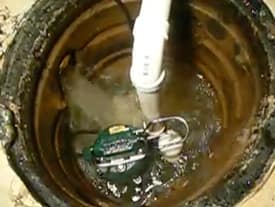Friday, April 7th, 2017
April Showers Bring Wet Basements

Our soggy winter has morphed into a soggy spring. Our backyard is soup. In Cincinnati, this means one thing: wet basements. For readers with sump pumps (or readers who would like one), a quick FAQ on sump pumps seems like a good read.
Q: What is a sump pump?
A: Many people think the “sump pump” is a device, but actually they are two things. A sump is a pit in which liquid collects. The pump is the device used to pump the liquid out of the sump. Typically, sumps are connected to drain tile that drains the footings of one’s house, generally under the entire basement.
There are 2 types of sump pumps: pedestal and submersible pumps
According to the North Dakota Extension Agency, “The pedestal pump has the motor on top of the pedestal and the pump at the base, which sits on the bottom of the sump. The motor is not meant to get wet. The pump is turned on and off by a ball float. One advantage of this type of pump is that the on/off switch is visible so the action of the ball float can be easily seen.
Submersible pumps are designed to be submerged in water and sit on the bottom of the sump. The on/off switch is attached to the pump and can be either a ball float connected to an internal pressure switch or a sealed, adjustable, mercury-activated floating switch.”
Both types of pumps should have a check valve on the water outlet pipe so water doesn’t flow back in the sump when the pump is not running.
Q: I don’t have a sump pump, but my basement leaks during heavy rains. Do I need a sump pump?
A: If the water flows to the floor drain, then backs up or drains slowly, a sump pump may solve your wet basement problems. The experts at the North Dakota Extension Agency suggest “small pumps, sometimes referred to as “skimmer” pumps, are designed to sit on a flat surface and pump when water on the floor is only 1/4 to 1/2 inch deep. They can often be used with….a 50-foot garden hose run out through a basement window. [The hose] will usually carry the water far enough away from the house. You can remove more water by taking the cover off the floor drain and placing the pump in the drain bowl—these pumps are usually small enough to fit in the bowl. In emergencies where electric service is off, these pumps can be powered by a small gasoline generator.”
A Quick Sump Pump Inspection is Time Well Spent
If your pump has been in place for more than a year (or loud, periodic thumping noises are coming out of the basement and it’s not the children), we recommend a quick visual inspection:
- First, unplug the sump pump to eliminate the risk of electric shock.
- Remove the pump cover, if possible. Note: if you cannot remove the cover, call a plumber.
- Look into the sump pit (use a flashlight for a better view). If the water in the pit has an oily appearance, it’s possible the pump is leaking coolant. Contact a reputable plumber immediately.
- Remove any foreign objects or debris that may have accumulated in the sump pit.
- Examine the pump float and make sure it moves freely
- Test the pump by plugging it back in and slowly pouring water into the pit until the float rises and the pump kicks on. Listen to the motor – is it running smoothly? It should not race, sputter or be overly noisy. Observe the pump until the excess water is removed from the pit.
Water You Waiting For? If you suspect your sump pump may need an official inspection or replacement, call Ray at Allied Reddi-Rooter before the spring thaw (and eventually, the spring rains).. He’ll listen, provide a free estimate, and has a trained staff that can assist on your schedule. Call today: 513-396-5300, or Contact us. We always come highly recommended and have earned an A+ rating from the Better Business Bureau for our expert quality of service.
